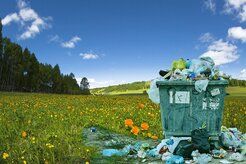
Plastic is everywhere, and it's hard to get rid of. It's cheap and protects its contents. But bags are especially hard to recycle, and recycling isn't a great solution anyways. Petroleum-based plastics stay in our environment for upwards of 1,000 years, contain toxic chemicals, and break down into microplastics that get into our water and our bodies. These companies are working to eliminate plastic polybags from their products, along with the Outdoor Industry's Plastic Impact Alliance:
- Fishing gear company Grundens uses bag made from material you can compost at home
- The problem: Plastic bags are cheap and effective, but create waste, climate change emissions and they’re hard to recycle. Most compostable packaging needs the heat and microbes of commercial composting facilities to properly break down and not create planet-warming gases, but this bag will dissolve in a home compost bin.
- Board sports apparel maker Picture Organic says “No” to the bag, “Yes” to the band
- As Picture grew their operations and logistics, at first they went along with standard convention in the industry to put everything in plastic bags. They questioned this need and dove into the specifics of how to best package different types of clothing. Beanies and hats didn’t need to be individually packaged at all. T-shirts, dresses and shorts could be “roll-packed” with a string or paper band. Technical gear could be folded further to reduce the size of bags. And along the way REI set a high bar for any of their suppliers that would ensure packaging waste was a priority.
- NEMO works with DAC poles to eliminate 100,000 polybags in two years
- Camping equipment maker NEMO started pulling product off their warehouse shelves and looked at what was actually necessary when it comes to packaging. Then they reached up the supply chain to the company that makes the poles for not only their tents, but for many in the industry, and worked with them to eliminate plastic bags that just weren’t needed. Now this change will work it’s way into other companies DAC supplies. This is a great example of working within the supply chain to spread environmental practices and make it easier for other companies to follow suit.

 RSS Feed
RSS Feed